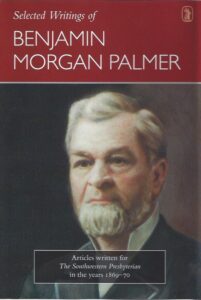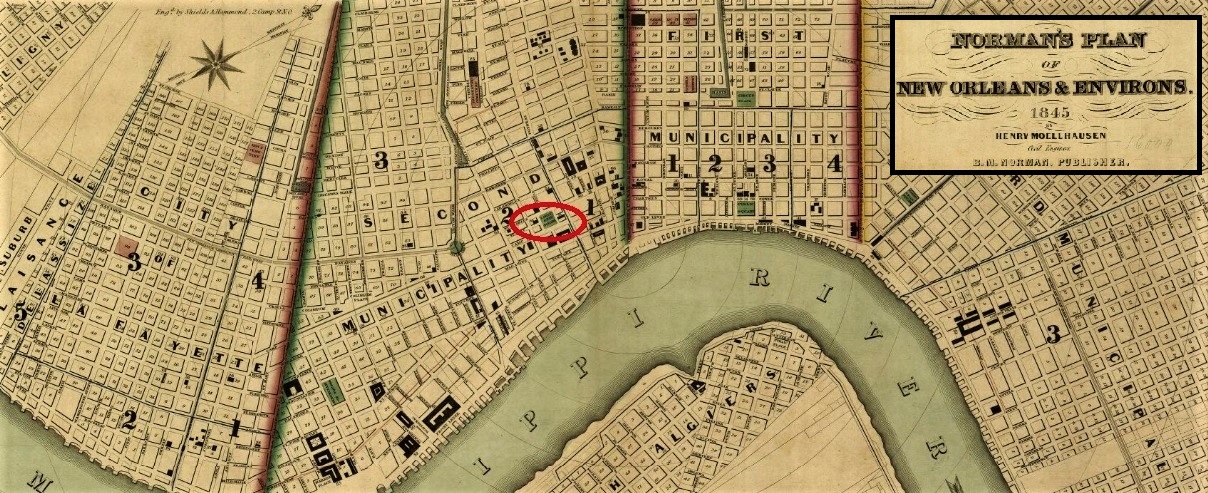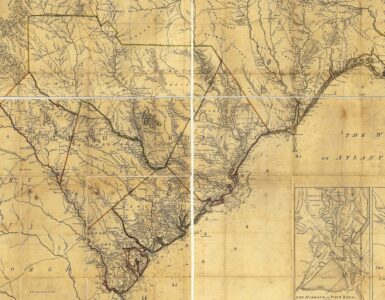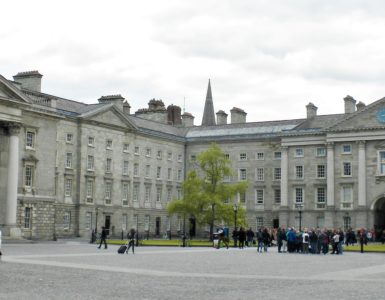The following review was first posted February 19, 2015. The content has not been changed but quite a bit of editing has been done. You will notice in the review that the comment about the wonders of modern medicine needs adjustment in these post-Covid years. The book remains available at Banner of Truth and the reviewer continues to recommended it highly. If you have not read any works by Victorian Presbyterians, this book is a good one for getting started.
C. N. Willborn and Caleb Cangelosi, eds., Selected Writings of Benjamin Morgan Palmer: Articles Written for the Southwestern Presbyterian in the Years 1869–1870, Carlisle: Banner of Truth Trust, 2014, cloth, 205 pages.
 The General Assembly of the Presbyterian Church in the United States (PCUS) gathered in First Church, Jackson, Mississippi, May 15, 1902. The retiring moderator, Neander M. Woods of Second Church, Memphis, delivered the opening sermon from 1 Samuel 13:19-22. Following prayer, the stated clerk reported that the Synod of Louisiana had been organized per the direction of the previous General Assembly with Benjamin Morgan Palmer moderator of the sessions. Palmer was a leader of the denomination, well known for his writings, and served a forty year call to First Church, New Orleans. Unfortunately, he was not able to attend the General Assembly because of severe injuries received a few days earlier when he was hit by a streetcar. Professor of Theology William T. Hall of Columbia Seminary was moderator when the Assembly resolved that “the richest ministrations of divine grace” join with our “earnest hope and prayer that he may yet long be spared to the church to which he is so dear” (GA Minutes, 248). However, shortly after the assembly adjourned, Pastor Palmer was taken home on May 25, 1902.
The General Assembly of the Presbyterian Church in the United States (PCUS) gathered in First Church, Jackson, Mississippi, May 15, 1902. The retiring moderator, Neander M. Woods of Second Church, Memphis, delivered the opening sermon from 1 Samuel 13:19-22. Following prayer, the stated clerk reported that the Synod of Louisiana had been organized per the direction of the previous General Assembly with Benjamin Morgan Palmer moderator of the sessions. Palmer was a leader of the denomination, well known for his writings, and served a forty year call to First Church, New Orleans. Unfortunately, he was not able to attend the General Assembly because of severe injuries received a few days earlier when he was hit by a streetcar. Professor of Theology William T. Hall of Columbia Seminary was moderator when the Assembly resolved that “the richest ministrations of divine grace” join with our “earnest hope and prayer that he may yet long be spared to the church to which he is so dear” (GA Minutes, 248). However, shortly after the assembly adjourned, Pastor Palmer was taken home on May 25, 1902.
The editors of Selected Writings of Benjamin Morgan Palmer, Caleb Cangelosi and C. N. Willborn, have brought together thirty-four articles published from 1869 to 1870 in a forgotten periodical titled The Southwestern Presbyterian. These articles provide a glimpse into Palmer’s ministry as pastor, expositor, evangelist, and apologist. The articles are organized into five sections. Each of the entries is brief with the shortest having three and the longest eight pages, and they could be read during snippets of time waiting for the children in car line at school or while anticipating the arrival of that friend who is always late to appointments. The handy size of the attractively dust jacketed book–five by seven inches–facilitates storage in small spaces for ready access.
The articles that are included in the first section, “Leaves from a Pastor’s Portfolio,” provide accounts of some of Palmer’s pastoral, evangelistic, and apologetic experiences. Included among the narratives are the conversion of a man anticipating death from yellow fever; salvation coming to an alcoholic suffering with the red death, tuberculosis; one person who believed in soteriological universalism and went to his grave thus deceived; and other examples of Palmer’s compassion, conviction, and constant confirmation of gospel truth. “Leaves from the Pastor’s Portfolio” reminds readers that life in the nineteenth century was often shortened by epidemics and diseases that are no longer feared thanks to God’s gracious work through medical science but they also remind readers there is nothing new when it comes to individuals suppressing the knowledge of God in defense of their unbelief.
One story in particular, “The Young Student,” provides a picture of Palmer dealing with an objection to the gospel. He relates a conversation held with a young college student while travelling by steamer on the Mississippi River. Palmer had recently spoken at a university commencement that the young man attended. As he approached Palmer he asked if they could discuss some of his doubts about religion. The student was concerned that, “the Bible is so full of mysteries, which I cannot comprehend” and then added “it does not seem reasonable, to me, that I should be required to believe what I do not understand.” Palmer asked him if he was sure he wanted to hold to his point of protest, to which the young man answered he would “wherever it may lead.” Palmer then, adopting a technique he attributed to John Mason’s tract, Conversation with a Young Traveler (what a coincidence), asked the inquirer to write down the fraction 1/3 and then also write it out in decimal form. Obediently, the student gave the fraction with the decimal having a long string of threes. Palmer asked him if the decimal version was at its end. He told the student to go ahead and write it until it was complete, but the student responded that even if he wrote a “line of figures to the North Pole” no terminus could be achieved. The decimal would continue to infinity, it was simply a mathematical fact. Palmer pointed out to the student that his principle of not believing what he could not comprehend was compromised. Thus, said Palmer, “You are not staggered at the infinite in mathematics; why should you be scandalized at the infinite in God.” They continued their discussion until the young man agreed to study the Bible more and expressed his appreciation to Palmer for his counsel. (A better illustration would have been pi, 3.141∞).
The next section is “Thoughts Upon Foreign Missions,” which is followed by the third section, “The Beatitudes.” Palmer provides expositions of the opening verses from the Sermon on the Mount by means of a series of nine articles drawn from the ideas of Rudolph Stier presented in his eight-volume work, The Words of the Lord Jesus, 1874–1875. Stier believed the verses show how the gospel brings one from poverty of spirit to mourning for sin, then meekness is pursued with recognition of one’s inability regarding salvation, then on to embracing and pursuing righteousness, maturing to show mercy, then purity of heart, and the goal is achieved with peace. Palmer commented that the biggest problem with the commentaries of his day was interpreting the beatitudes as general “ethical propositions,” which is a problem that continues in many current commentaries.
The fourth section, “Christian Paradoxes,” includes four entries that provided solutions to apparent contradictions in Scripture. For example, the first article observes that Galatians 2:20 speaks of being crucified with Christ which yields death to self but life to grow in sanctification, and then Colossians 3:3 teaches that the believer has died but is alive with Christ in God. Crucifixion and death appear to contradict living, but true living is achieved throw death as one grows in sanctification. As the article ends, Palmer concluded that the noblest individuals within humanity are those that profess the deepest sense of personal unworthiness. The next three entries address the paradoxes of having fearful awe for God while taking intimate confidence in him; having a keen sense of sorrow in life yet maintaining composure and peace of soul; and the believer is dead to the world while enjoying the goodness of new life within God’s handiwork.
The book ends with “Miscellanies on Christian Experience,” which is followed by an afterward from Richard D. Phillips, pastor of Second Presbyterian Church in Greenville, South Carolina. He says of Palmer that his example for today is shown in his “personal passion for Jesus, his fervent commitment to scriptural truth, and his sacrificial love for people” and that “he offers such inspiration to those of us who minister the gospel in the chaotic times that we face today.”
Two comments will express ways the book could have been better. First, there are a few occurrences of the term, “professor of religion.” In Palmer’s day this referred to one who was a professor of faith in Christ; the modern version would be a believer in Christ. The trouble is that for a time Palmer was a seminary professor, so the term occasionally caused the reviewer pause to interpret the meaning from the context. A note regarding the meaning of this Victorian usage as well as others could have helped readers new to nineteenty-century books. An addition that would have facilitated use of the book is a brief subject index. A help that can be learned from the past is that the table of contents often included a few lines summarizing the subjects of each chapter.
The Selected Writings of Benjamin Morgan Palmer recounts the experiences of a dedicated pastor who served his denomination faithfully. Even though twenty-first century ministers might think they are beyond learning from an old book containing wisdom from an experienced nineteenth-century pastor, the articles show that the work of shepherding is essentially the same today as then because pastors visit the sick, minister the Word & sacraments, and respond to the challenges of those who do not believe the gospel.
Barry Waugh
Notes–The header shows First Church, New Orleans, circa 1845, before Palmer’s day; it is from the Library of Congress Digital Collections. First Church is at the upper left corner of Lafayette Square and is marked by the red ellipse but this building burned in 1854, Palmer ministered in a different one beginning in 1856. The article,“Charles A. Stillman, 1819-1895,” is about the founder of the Stillman Institute established in Alabama to educate African Americans for the ministry. Stillman was moderator of the PCUS General Assembly at First Church, New Orleans, 1877. Stillman’s The Pulpit and the Pastorate, is available from Log College Press, and Palmer’s works can be downloaded at LCP here, “Benjamin Morgan Palmer (1818-1902).”





